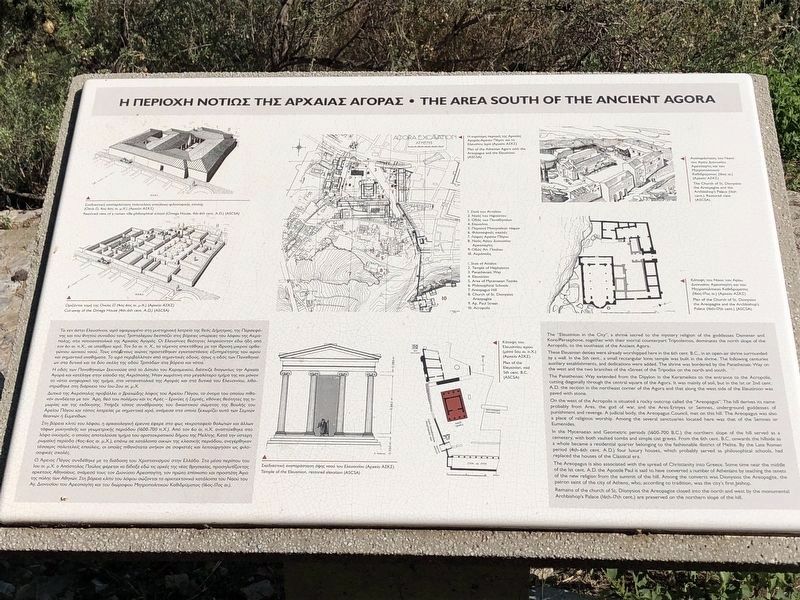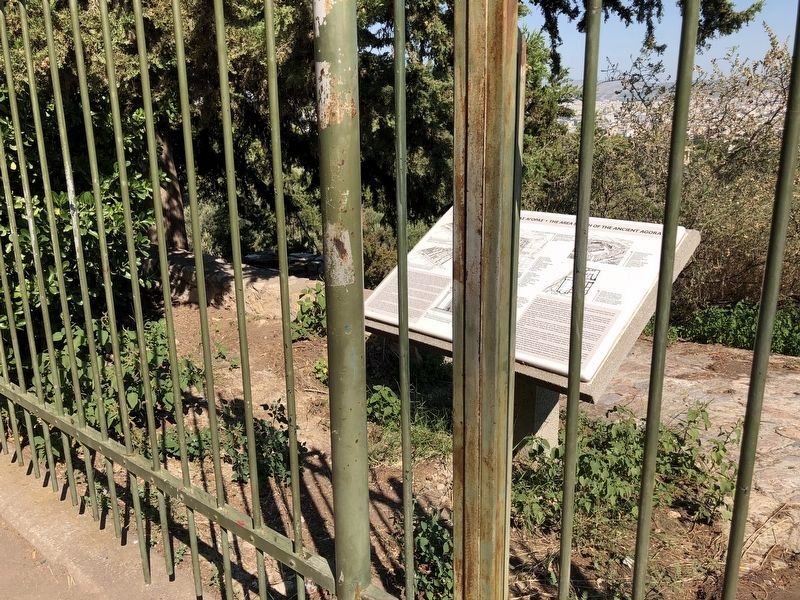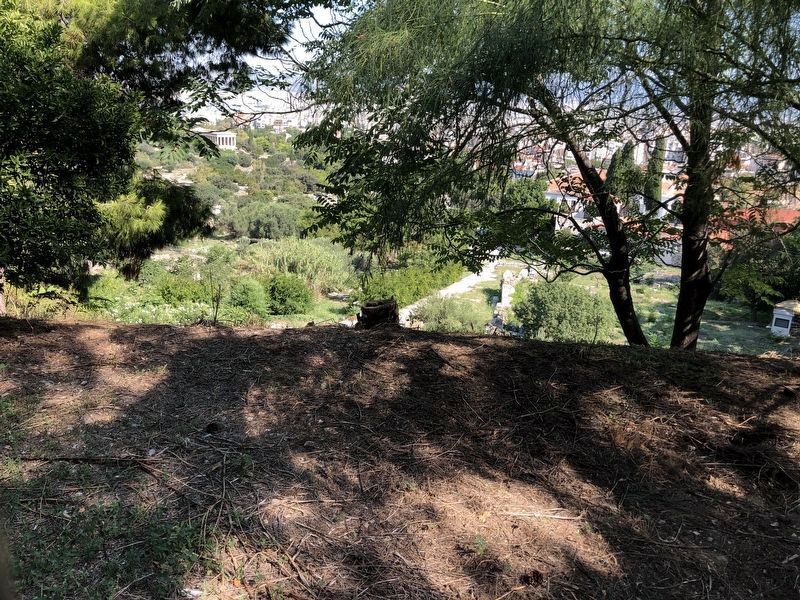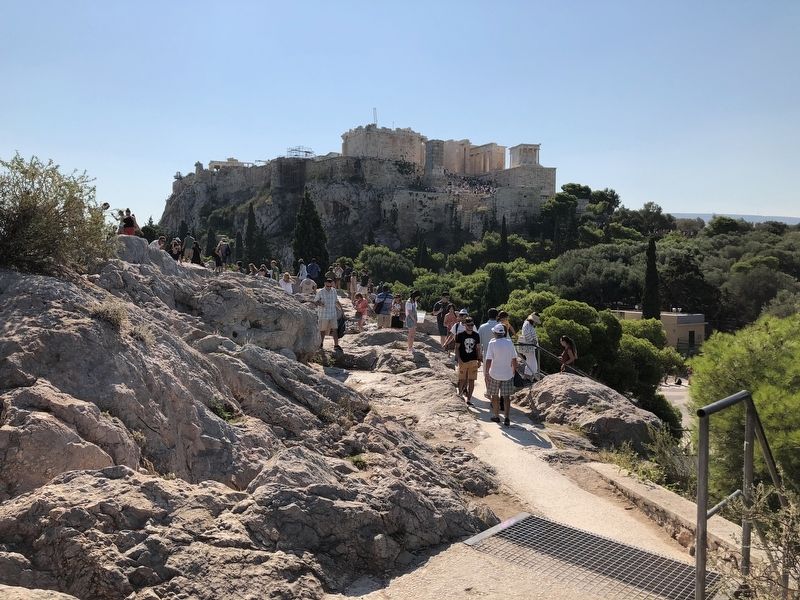Athina in Kentrikos Tomeas Athinon, Attica, Greece — Ελλάδα (Southeastern Europe, Balkan Peninsula)
The Area South of the Ancient Agora

Photographed By Barry Swackhamer, July 19, 2018
1. The Area South of the Ancient Agora Marker
Captions: (top left) Restored view of a roman villa-philosophical school; (middle left) Cut-away of the Omega House (4th-6th cent A.D.); (top center) Plan of the Athenian Agora with the Areopagus and the Eleusnion. 1. Stoa of Attalos, 2. Temple of Hephaistos, 3. Panatheansic Way, 4. Eleusinion, 5. Area of the Mycenaean Tombs, 6. Philosophical Schools. 7. Areopagus Hill, 8. Church of St. Dionysios Areopagite, 9. Ap. Paul Street, 10. Acropolis; (bottom center) Temple of the Eleusinion, restored elevation, Plan of the Eleusinion, mid-5th cent. B.C.; (top right) The Church of St. Dionysios the Areopagite and the Archbishop;s Palace (16th cent.); (middle right) Plan of the Church of St. Dionysios the Areopagite and the Archbishop;s Palace (16th cent.)
(Text in Greek on the left side. To read it enlarge the marker image.)
English:
The "Eleusinion in the City", a shrine sacred to the mystery religion of the goddesses Demeter and Kore/Persephone, together with their mortal counterpart Triptolemos, dominated the north slope of the Acropolis, to the southeast of the Ancient Agora.
These Eleusinian deities were already worshipped here in the 6th cent. B.C. in an open-air shrine surrounded by a wall. In the 5th cent. a small rectangular Ionic temple was built in the shrine. The following centuries auxiliary establishments, and dedications were added. The shrine was bordered by the Panathenaic Way on the west and the two branches of the «Street of the Tripods» on the north and south.
The Panathenaic Way extended from the Dipylon in the Keramelkos to the entrance to the Acropolis, cutting diagonally through the central square of the Agora. It was mainly of soil, but in the 1st or 2nd cent. A.D. the section in the northeast corner of the Agora and that along the west side of the Eleusinion was paved with stone.
On the west of the Acropolis is situated a rock outcrop called the "Areopagus". The hill derives its name probably from Ares, the god of war, and the Ares-Erinyes or Semnes, underground goddesses of punishment and revenge. A judicial body the Areopagus Council met on this hill. The Areopagus was also a place of religious worship. Among the several sanctuaries located here was that of the Semnes or Eumenides.
In the Mycenaean and Geometric periods (1600-700 B.C.) the northern slope of the hill served as a cemetery, with both vaulted tombs and simple cist graves. From the 6th cent. B.C. onward the hillside as a whole became a residential quarter belonging to the fashionable district of Melite. By the Late Roman period (4th-6th cent. A.D.) four luxury houses, which probably served as philosophical schools, had replaced the houses of the Classical era.
The Areopagus is also associated with the spread of Christianity into Greece. Some time near the middle of the 1st cent. A.D. the Apostle Paul is said to have converted a number of Athenians by teaching the tenets of the new religion from the summit of the hill. Among the converts was Dionysios the Areopagite, the patron saint of the city of Athens, who, according to tradition, was the city's first bishop.
Remains of the church of St. Dionysios the Areopagite closed into the north and west by the monumental Archbishop's Palace (16th-17th cent.) are preserved on the north slope of the hill.
Topics. This historical marker is listed in these topic lists: Architecture • Industry & Commerce • Man-Made Features.
Location. 37° 58.358′ N, 23° 43.483′ E. Marker is in Athina, Attica, in Kentrikos Tomeas Athinon. Marker can be reached from Aretousas near Panos. Touch for map. Marker is at or near this postal address: Aretousas 8, Athina, Attica 105 55, Greece. Touch for directions.
Other nearby markers. At least 8 other markers are within walking distance of this marker. Areopagus Hill (about 120 meters away, measured in a direct line); The Statue of Athena Promachos (about 120 meters away); A. The Propylaia, B. The Shrine of Athena Hygieia and Hygieia (about 120 meters away); The House on Panos Street (about 120 meters away); A. The Sanctuary of Artemis Brauronia, B. The Chalkotheke (about 150 meters away); The Acropolis of Athens (about 150 meters away); The Parthenon (about 150 meters away); Church of the Holy Apostles (ca. A.D. 1000) (about 180 meters away). Touch for a list and map of all markers in Athina.
More about this marker. The marker is on a footpath west leading from the intersection of Theories and Panos to Areopagus Hill.
Credits. This page was last revised on March 21, 2022. It was originally submitted on November 10, 2018, by Barry Swackhamer of Brentwood, California. This page has been viewed 161 times since then and 11 times this year. Photos: 1, 2, 3, 4. submitted on November 10, 2018, by Barry Swackhamer of Brentwood, California.


